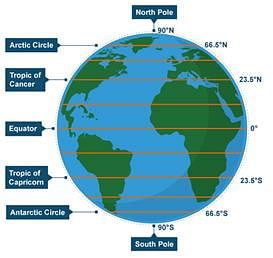UPSC Exam > UPSC Tests > Geography for UPSC CSE > Important Questions Test: Globe Latitudes And Longitudes - UPSC MCQ
Important Questions Test: Globe Latitudes And Longitudes - UPSC MCQ
Test Description
20 Questions MCQ Test Geography for UPSC CSE - Important Questions Test: Globe Latitudes And Longitudes
Important Questions Test: Globe Latitudes And Longitudes for UPSC 2024 is part of Geography for UPSC CSE preparation. The Important Questions Test: Globe Latitudes And Longitudes questions and answers have been
prepared according to the UPSC exam syllabus.The Important Questions Test: Globe Latitudes And Longitudes MCQs are made for UPSC 2024 Exam. Find important
definitions, questions, notes, meanings, examples, exercises, MCQs and online tests for Important Questions Test: Globe Latitudes And Longitudes below.
Solutions of Important Questions Test: Globe Latitudes And Longitudes questions in English are available as part of our Geography for UPSC CSE for UPSC & Important Questions Test: Globe Latitudes And Longitudes solutions in
Hindi for Geography for UPSC CSE course. Download more important topics, notes, lectures and mock
test series for UPSC Exam by signing up for free. Attempt Important Questions Test: Globe Latitudes And Longitudes | 20 questions in 20 minutes | Mock test for UPSC preparation | Free important questions MCQ to study Geography for UPSC CSE for UPSC Exam | Download free PDF with solutions
Detailed Solution for Important Questions Test: Globe Latitudes And Longitudes - Question 1
Important Questions Test: Globe Latitudes And Longitudes - Question 2
The Standard Meridian of India is 82 degree 30
Detailed Solution for Important Questions Test: Globe Latitudes And Longitudes - Question 2
| 1 Crore+ students have signed up on EduRev. Have you? Download the App |
Important Questions Test: Globe Latitudes And Longitudes - Question 3
The 0 degree Meridian is also known as
Detailed Solution for Important Questions Test: Globe Latitudes And Longitudes - Question 3
Important Questions Test: Globe Latitudes And Longitudes - Question 4
The distance between the longitude
Detailed Solution for Important Questions Test: Globe Latitudes And Longitudes - Question 4
Important Questions Test: Globe Latitudes And Longitudes - Question 5
In the globe, Two end point of the axis are called
Detailed Solution for Important Questions Test: Globe Latitudes And Longitudes - Question 5
Important Questions Test: Globe Latitudes And Longitudes - Question 6
The Arctic Circle is located in the
Detailed Solution for Important Questions Test: Globe Latitudes And Longitudes - Question 6
Important Questions Test: Globe Latitudes And Longitudes - Question 7
______ measure the distance north and south of the Equator
Detailed Solution for Important Questions Test: Globe Latitudes And Longitudes - Question 7
Detailed Solution for Important Questions Test: Globe Latitudes And Longitudes - Question 8
Important Questions Test: Globe Latitudes And Longitudes - Question 9
The line which cut the world into north and south latitude
Detailed Solution for Important Questions Test: Globe Latitudes And Longitudes - Question 9
Important Questions Test: Globe Latitudes And Longitudes - Question 10
This marks the location of the equator on Earth
Detailed Solution for Important Questions Test: Globe Latitudes And Longitudes - Question 10
Important Questions Test: Globe Latitudes And Longitudes - Question 11
Why are the regions called Frigid Zones very cold?
Detailed Solution for Important Questions Test: Globe Latitudes And Longitudes - Question 11
Important Questions Test: Globe Latitudes And Longitudes - Question 12
What are latitude and longitude lines?
Detailed Solution for Important Questions Test: Globe Latitudes And Longitudes - Question 12
Important Questions Test: Globe Latitudes And Longitudes - Question 13
Days and nights are equal throughout the globe when the sun is above:
Detailed Solution for Important Questions Test: Globe Latitudes And Longitudes - Question 13
Important Questions Test: Globe Latitudes And Longitudes - Question 14
Describe the shape of the Earth?
Detailed Solution for Important Questions Test: Globe Latitudes And Longitudes - Question 14
Important Questions Test: Globe Latitudes And Longitudes - Question 15
The tropic of cancer and tropic of Capricorn are of
Detailed Solution for Important Questions Test: Globe Latitudes And Longitudes - Question 15
Important Questions Test: Globe Latitudes And Longitudes - Question 16
Identify the red line in the picture. Options are as follows
Detailed Solution for Important Questions Test: Globe Latitudes And Longitudes - Question 16
Detailed Solution for Important Questions Test: Globe Latitudes And Longitudes - Question 17
Detailed Solution for Important Questions Test: Globe Latitudes And Longitudes - Question 18
Important Questions Test: Globe Latitudes And Longitudes - Question 19
The Northernmost end of the axis is ______
Detailed Solution for Important Questions Test: Globe Latitudes And Longitudes - Question 19
Detailed Solution for Important Questions Test: Globe Latitudes And Longitudes - Question 20
|
180 videos|475 docs|198 tests
|
Information about Important Questions Test: Globe Latitudes And Longitudes Page
In this test you can find the Exam questions for Important Questions Test: Globe Latitudes And Longitudes solved & explained in the simplest way possible.
Besides giving Questions and answers for Important Questions Test: Globe Latitudes And Longitudes, EduRev gives you an ample number of Online tests for practice
|
180 videos|475 docs|198 tests
|
Download as PDF


















